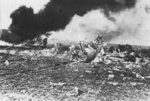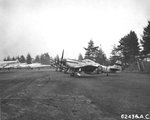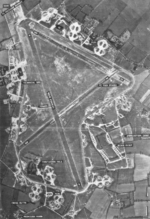Debach Airfield
| Type | 191 Air Base | |
| Historical Name of Location | Woodbridge, England, United Kingdom | |
| Coordinates | 52.138875000, 1.269739000 |
Contributor: Alan Chanter
ww2dbaseNestled between the small villages of Debach and Clopton, three miles southeast of Woodbridge, in a quiet and secluded corner of Suffolk, US Station 152 would be the home to the fortieth and last combat unit to join the "Mighty" Eighth Air Force in England. The airfield was built in 1942 by personnel of the 820th and 829th Engineer Battalions (Aviation) of the US Army with additional assistance from a number of British sub-contractors. Most villagers remember the day when "the Yanks arrived!" It was quite a surprise for them to find that many of them were "black skinned", the first time many Suffolk people had seen a coloured person. They found them polite and courteous, and many local people recall that they were not aware of any "colour bar" until the white American servicemen arrived!
ww2dbaseLike other heavy bomber stations constructed at this stage in the war, the airfield was provided with three concrete and tarmac runways - The longest was 2,000 yards long by 50 yards wide and the other two were 1,400 yards long by 50 yards wide. In addition some fifty loop dispersal or hard-standings and two T2 hangers were positioned around the airfield. These new airfields, of which dozens would be constructed across the sleepy rural East Anglian countryside during 1942-43 as bases for the incoming American airmen, would typically require some thirty miles of drainage, a large sewage plant and as many as five hundred temporary buildings. At Debach the Group Headquarters, technical and living accommodation for the 421 officers and 2,473 enlisted ranks were built on farmland towards Clopton village with additional billets established in a very fine house, Thistleton Hall, located to the south-west of the main runway. Regrettably the Hall would suffer so much damage that it had to be demolished at the end of the war.
ww2dbaseDebach airfield (or US Air Station 152 as it was to be officially known to the USAAF) opened in April 1944 with the aircraft of the American 493rd Heavy Bombardment Group (equipped with the latest Consolidated B-24H and B-24J Liberator bombers) arriving during the following month. The 493rd Bombardment Group, along with the 490th Group at Eye and the 34th Group at Mendlesham, would form the 93rd Combat Bomb Wing of the Third Bombardment Division under the command of Brigadier General John K. Gerhart. In order to establish some sort of positive Group identity, instead of the anonymity of being just another number, the personnel chose the sobriquet of "Helton’s Hellcats", named after their Commanding Officer, Colonel Elbert Helton. The Group's four subsidiary squadrons were the 860th BS (Shunter), 861st BS (Begman), 862nd BS (Compar) and 863rd BS (Pilar).
ww2dbaseThe group's first operation occurred on D-Day, 6 June 1944, when the Eighth Air Force put 2,362 bombers airborne in support of the Normandy landings in France. Unfortunately, and probably due to inexperienced crews, two of the groups' aircraft were lost in a fatal collision on that famous day. Following this inauspicious start the next month was spent attacking rail targets and airfields in France as well as V1 rocket sites in the Pas de Calais. Then on the 20 June the 493rd undertook its first mission into Germany. A giant bomber stream over 200 miles long was despatched to attack oil plants, aircraft factories and a ball-bearing factories. Thankfully no serious resistance was met from the Luftwaffe on this occasion and the "Hellcats" returned to Debach without loss having achieved their satisfactory debut into the enemy's homeland. The "Hellcats" however would soon discover that the deadly Luftwaffe Messerschmitt and Focke-Wulf fighters were far from being a spent force.
ww2dbaseShortly after, all the heavy bomber Groups in the Third Division were ordered to exchange their B-24 Liberator bombers for B-17G Flying Fortress bombers. Operating the two heavy bomber types jointly had been found to present increasing difficulties because of the differences in range, cruising speed, bomb loads and operational altitudes. This could make organising combat missions with both types exceedingly complex. At first there was some natural resentment among the crews regarding the change of aircraft but it was not long before they began to realise the merits of the B-17 (e.g. easier to handle, more comfortable and better heating than the B-24). The group's last, and 47th mission with the B-24 was on 24 August 1944 and within two weeks the crews were ready to undertake their first B-17 mission - an attack on an Ordnance factory at Mainz, Germany. By the end of September the "Hellcats" had completed fourteen B-17 missions for the loss of sixteen aircraft (seven of which were shot down during a particularly disastrous raid on Magdeburg, Germany.
ww2dbaseA little light relief from the constant perils of air combat occurred in October when one of the airfield hangers was turned into a cinema and used by MGM for the world premiere of Lana Turner's new film "Marriage in a Private Affair!" This came about because the Movie studio had decided to honour the crew of a B-17 bomber of 862nd Squadron who had named it "Tempest Turner" after the famous Hollywood actress.
ww2dbaseAn unfortunate incident occurred at the airfield in December when the B-17 bomber "Devil’s Own" crashed and burst into flames while attempting a belly landing with its bombs still on board. Lieutenant John De Witt and his crew scrambled out seconds before the aircraft blew up with a terrific explosion which spread much damage extensively across the airfield. On 10 January 1945 the 493rd reached their 100th mission - an attack on the Hohenzollern railway bridge near Cologne, Germany. Icy conditions, freezing fog and heavy snowfall presented a serious difficulty for the heavily laden bombers attempting to get airborne (several got stuck in snow drifts and one crashed shortly after take-off) but all thirty aircraft that did bomb the target returned home without any further loss.
ww2dbaseIn February 1945 Debach lost 862nd Squadron, which was transferred to Wormingford in Essex to become the 3rd Scouting Force. With stripped down B-17 bombers this squadron was tasked with providing the 3rd Air Division with vital weather information over specified target areas. During the same month Colonel Helton departed to take on a desk job. His replacement, Colonel Robert Landry, had previously been the commander of one of the finest fighter groups in the Eighth Air Force - the famed 56th Fighter Group "The Wolfpack" - whose pilots had included two of the highest scoring fighter pilots of the war, Francis Gabreski and Robert Johnson (q.v.). Colonel Landry therefore became the only senior officer in the Eighth Air Force to command both a fighter and a bomber Group.
ww2dbaseOn 22 February the 493rd contributed its bombers to Operation Clarion - the Allied Air Forces' massive onslaught on Germany's road, rail and canal communications. On the first day the Debach group went to Bamberg in south-central Germany and on the following day they were sent to Ansbach, even further south. On both occasions all the group’s aircraft returned safely. In fact, in this two day operation just eight aircraft were lost out of some 2,700 bombers (escorted by thousands of fighters) that had participated. A testimony to the awesome might of the Eighth Air Force at this stage in the war.
ww2dbaseDuring March the airfield was temporarily closed to flying in order to allow urgent repairs to be made to the runways. It had become apparent that the concrete and tarmac surfaces were not going to withstand the constant wear and tear of daily heavy-bomber usage - poor construction technique being blamed, one of the few examples of poor airfield construction. The aircraft and crews were therefore briefly moved to Little Walden in North Essex (formerly home to the 361st Fighter Group which had now relocated to Belgium). They returned to Debach at the end of the month and were quickly able to resume operations from their home base once again. By 7 May 1945, when the Group finally completed Operation Chowhound - the air delivery of food to the starving Dutch population still under German occupation, the group's final tally, since arrival in Suffolk, amounted to 158 missions completed for the loss of forty-one aircraft missing in action and thirty-one from other operational causes.
ww2dbaseWith the war over, Debach was soon abandoned by the Americans, the aircraft flying out in June and July and by the first week of August all the Americans had departed. Perhaps somewhat ironically the airfield buildings were now used to house German prisoners of war and later as accommodation for displaced persons. The base was finally closed down in 1948 and the site ultimately sold off for agricultural use, although a number of buildings would be sold for industrial usage.
ww2dbaseLittle remains of the airfield today. It can be reached by taking the B1079 from the A12 at Woodbridge through the villages of Grundisburgh and Clopton and then right into the B1078 at Clopton Corner. Here, on the right, the original entrance to the old airfield can still be found. Two memorials to the United States Station 152 stand at the site. The principle memorial is set back in front of an office building while, in Clopton Church, a Roll of Honour is on display in one corner beneath the Flag of the USA. For many years the old control tower, becoming increasingly dilapidated, was situated on private land and permission was needed to search for it. More recently, however, a group of local volunteers have carried out a renovation project at the site and opened a non-charitable museum which regularly holds events and open days in tribute to those brave American airmen who gave their lives in the cause of freedom.
ww2dbaseSources:
Graham Smith, Suffolk Airfields in the Second World War (Countryside Books, 1995)
Ken Delve, The Military Airfields of Britain-East Anglia-Norfolk and Suffolk (Crowood Press, 2005)
Dennis F. Lain, Memorials to the Mighty Eighth (Serendipity, 2004)
Debach Airfield Museum Website
Plus additional material from several other publications
Last Major Update: Sep 2017
Debach Airfield Interactive Map
Photographs
 |  |  |  |
Debach Airfield Timeline
| 12 Dec 1944 | B-17 bomber 'Devil's Own', piloted by Lieutenant John E. DeWitt, landed at RAF Debach in eastern England, United Kingdom with a burning engine. Moments after he and his crew safely evacuated the aircraft, the fire detonated its bomb load, destroying the aircraft and damaging nearby facilities. |
Please consider supporting us on Patreon. Even $1 per month will go a long way! Thank you. Please help us spread the word: Stay updated with WW2DB: |

Woodbridge, England, United Kingdom
Latitude-Longitude:
52.1389, 1.2697
- » 1,176 biographies
- » 337 events
- » 44,933 timeline entries
- » 1,245 ships
- » 350 aircraft models
- » 207 vehicle models
- » 376 weapon models
- » 123 historical documents
- » 261 facilities
- » 470 book reviews
- » 28,469 photos
- » 365 maps
General Douglas MacArthur at Leyte, 17 Oct 1944
Please consider supporting us on Patreon. Even $1 a month will go a long way. Thank you!
Or, please support us by purchasing some WW2DB merchandise at TeeSpring, Thank you!